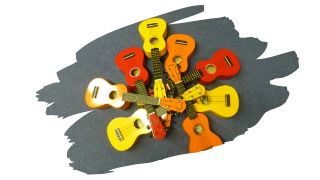If you’re new to ukuleles, (or you’re making the jump over from guitars), choosing the right type of ukulele can be tricky.
That’s because not all types of wood make for good ukuleles. What’s more, not all wood ukuleles are even made from solid wood. And if you’re wondering, you can get laminated ukuleles too, which is a sort of veneered type of engineered wood similar to Plywood.
Still, if there’s one thing that’s certain in life, it’s that some types of solid wood are much more costly than others. So, if you can manage to substitute one type of wood for another, you can get the same quality for a fraction of the price.
Take for example, Sapele wood. This reddish-brown lumber is famously used as a more affordable alternative to Mahogany. That’s because Sapele is a durable hardwood that’s a cut above the rest. Yet, how does Sapele wood rate as a ukulele tonewood?
Well, in this article, you will discover why Sapele makes for such a great alternative to Mahogany wood. You’ll also learn what kind of sound this tonewood produces…and whether or not it’s all that different from Mahogany.

This post may contain affiliate links to products that we receive a commission for (at no additional cost to you). Learn more here.
What Type Of Wood Is Best For A Ukulele?
Traditionally, Ukulele’s are made from Koa wood, which is a dense hardwood that grows widely across Hawaii.
It is a fairly pricey type of wood too, which is why you can also get ukuleles made from more affordable Spruce, Mahogany, and Cedar wood. These four wood types are what’s used to make the top of a Ukulele.
However, when it comes to making the main body of this instrument, (namely the sides and the bottom), less dense wood types (such as Spruce and Cedar wood) aren’t suitable for the sound box.
Which is why, when it comes to making the sides and bottom of a Ukulele, we don’t use Spruce or Cedar. Although you can still use Koa and Mahogany for these parts of the instrument.
Instead, denser hardwoods, (such as Rosewood and Maple), are the go to wood types for the sound box.
Related Post: Can Tru-Oil Really Finish And Protect Your Maple Fretboard?
And What About Sapele? Is Sapele Like Mahogany?
Sapele is so similar to Mahogany, that they both belong to the same tree family. Also known by the name of Sapele Mahogany, Sapele wood can be found growing right across West Africa.
On the other hand, the Mahogany wood we’re more familiar with, grows in America. Sometimes referred to as Genuine Mahogany, this tree species can be found thriving in South America.
Still, (other than where they’re harvested), the key difference between Sapele and Mahogany is their density.
Sapele is denser and heavier than Mahogany. Which is why it is used not only to make instruments, but also floors, moldings, and solid wood doors.
Related Post: What You Need To Know About Alder Vs Mahogany Wood
How Much Harder Is Sapele Than Mahogany?
Well, if we go by their Janka ratings, Sapele is around 60% to 70% harder than Mahogany.
You see, when it comes to judging how hard a piece of wood is, we use something called the Janka Hardness Scale. This scale measures how well wood can resist any compressional stresses put on it.

Or, to put it simply, the Janka scale measures how much force (lbf) it takes to crack a piece of lumber. The higher the Janka rating of wood, (on the Janka Hardness Scale), the harder that piece of wood is.
Now, Genuine Mahogany has a Janka rating of 900 lbf. So, it will take 900 lbs of force to crack through this dark brown timber.
However, Sapele wood has a Janka rating of 1510 lbf. Which means it will take 1510 pounds of force to even scratch the surface of this tough hardwood.
Now, when it comes to floors and furnishing, density matters a lot for durability. Yet, when it comes to musical instruments, the density of wood matters more for the quality of sound it produces.
Is Sapele A Good Tonewood? Does It Sound Like Mahogany?
When it comes to sound quality, Sapele sounds very similar to Mahogany. You’re going to end up straining your ears to try and find any difference in either tonewood.
In other words, both Sapele and Mahogany produce mid-range tones. Although their sound is not quite as mellow as the sound that Koa wood produces.
Related Post: A Quick Guide To Acacia Koa Vs Mahogany (For Ukuleles)
Is Sapele Cheap Wood?
Sapele is cheaper than Koa and Mahogany. Which is why it’s often used as a Mahogany wood substitute for musical instruments.
But, it is far from being a cheap wood. And that’s all thanks to Sapele’s Class 1 rating.
Class 1 woods are very rot-resistant and naturally durable. These wood types are perfect for outdoor structures, and they can last decades without succumbing to decay.
So, put Sapele more in the mid-range price for a ukulele wood choice. Especially since this tropical hardwood costs more than Spruce or Cedar.
To Sum Up, Here Are The 3 Key Takeaways From This Post…
- 1). Sapele is very similar to Mahogany wood, as they belong to the same tree family.
- 2). Sapele is heavier, and denser than Mahogany wood. Although, it costs less per board foot.
- 3). You can easily substitute Mahogany for Sapele, without losing sound quality. That’s because Sapele tonewood produces a sound very similar to Mahogany.
References:
Dadzie, Peter Kessels, and Martin Amoah. “Density, some anatomical properties and natural durability of stem and branch wood of two tropical hardwood species for ground applications.” European Journal of Wood and Wood Products 73.6 (2015): 759-773.
